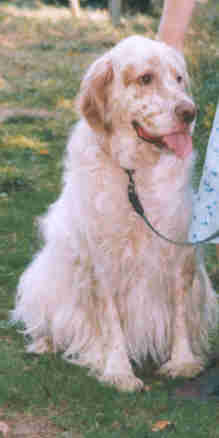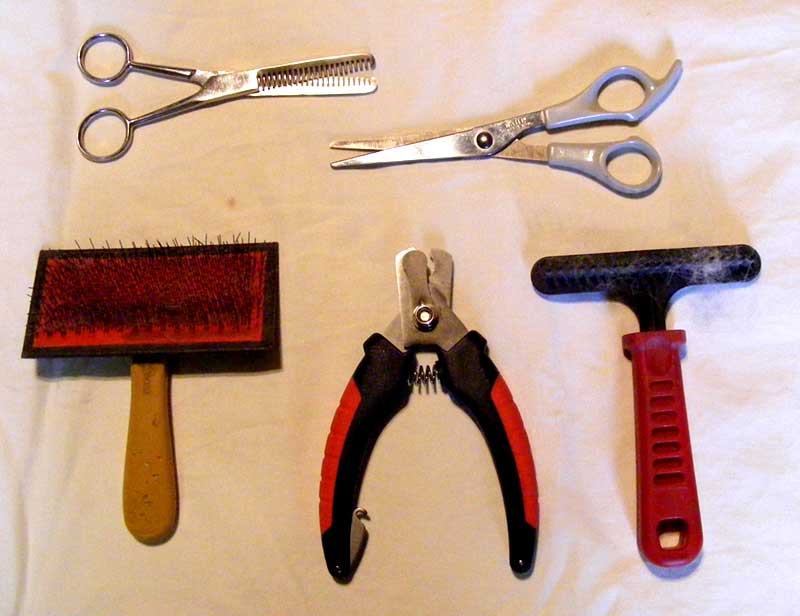
Angus and Rosemary's Miscellany
of Malvern - Other Resources
|
Other Resources > Owning an English SetterAbout our dogs
He was so nice we adopted a second setter aged 18 months from a young couple in Cheltenham who later emigrated to Perth in Western Australia. We were matched up through a very helpful lady in the Midlands English Setter Society. Our second setter's kennel name was Covarney Cognac and you will find more about his pedigree at the bottom of this page. He was an Orange Belton, strong and broad chested (for a setter) and pulled on the lead like a steam train. He was also a 'chewer' preferring books, bannisters and skirting boards to slippers and shoes. He loved a game of 'chase me' and would for example steal a shoe or pair of glasses and race round the garden with them. If left for an hour he would often knock things off the kitchen work surface, chew them and ferret in the bin. In short he was a teenage delinquent compared to our senior dog, which came as a surprise, but we persevered and gradually we got to know each other better and he settled down. We attended Sue Harper's dog training classes together and as Sue put it, it was as much about training the owners as training the dog! Before the classes he only knew one command which was sit, and after the classes he still only reliably obeyed one command - sit! However it was a very good command - if he had stolen something there was no point in chasing him, but if you told him to sit very firmly he would stop racing about and either give the item to you or drop it at your feet. We also diverted him from chewing the furniture by providing rubber and edible chews. The best item was a large chew you could put food inside. Unlike the Kong this one was green with spiky bumps on its surface and marked - indestructible. He spent hours chewing that and it took him several months to destroy it. It's not exactly clear what stopped him wreaking havoc in the kitchen, but booby trapping the work surfaces with towers of empty lager cans loosely tied together with string seemed to help. We found pulling on the lead difficult to stop. We tried a choke chain but to no effect and then a Halti which is a miniature version of the halter used for horse but he hated that. In the end we found a strong extending tape lead the complete answer. This allowed him the freedom to nose around, while we (usually) had ultimate control. However there was the one occasion when a cat streaked across our path and he took off in pursuit - It is surprising how fast a seemingly lazy dog can accelerate. All was well until the extending lead reached the end of its travel. Finding your arm suddenly attached to 40 Kilos of dog traveling at speed is a painful experience but fortunately there was no permanent damage to either of us. Having been a town dog, it was fun to watch him 'point' at the sound of tweeting birds and gaping when he first saw cows and horses. He was always up for pursuit of birds rabbits, squirrels and cats. Cats that ran were always worth a chase, but round here there are cats made of sterner stuff who stand there ground and are prepared to give a dog a sharp swipe round the face with their claws. So when we met those cats we diverted him round to avoid a cut nose or possible loss of an eye. ExerciseIf you are thinking of getting a setter, be prepared to spend up to three hours a day exercising, feeding and grooming your pet. They are large dogs and somewhere will be needed for their bed. They will be quite happy to lie on your settee or bed, but if you don't want muddy paws on the furniture tell them 'no' from the start and provide them with their own basket or bean bag. Ideally setters should get two walks a day, one in the morning and one in the afternoon, with some free running off the lead, so you will need access to suitable open spaces. In poor weather they may come in wet and muddy, so you will need a towel and somewher to dry them off. Putting muddy paws into a bucket of water to clean them off can be a good idea. Water will run off the coats of some dogs but the coats of our setteres became soggy in the wet and were difficult to dry so eventually we got a waterproof coat. Then it was only necessary to dry their head and legs. Your dog will almost certainly want to rummage and dig in the garden so if you love your flower beds perhaps a setter is not for you; else think about some plastic coated wire netting to separate him or her from your plants. While on the subject of netting, be aware dogs can wriggle through surprisingly small gaps in fences and some will jump four foot gates to meet friends in the road! FeedingWe found it best to give our dogs two small meals a day rather than one big one. We tried various foods but he seemed to find dried Bakers Chicken Complete as good as any, especially if mixed or followed by leftovers from lunch and supper. Our first dog had poor teeth so for dental health reasons we avoided sweet sticky foods and marrow bones which he would have enjoyed but might have damaged his teeth. Grooming equipmentThe English Setter has a long coat which needs daily grooming to prevent matting. Matted fur and entangled burs and twigs may need to be carefully cut out with scissors.
Scissors Thinning scissors Wire slicker brush Rake to remove hair from the slicker brush Large nail; clippers In the Spring it's a good idea to get your dog clipped before the hot weather. If you are going to bath your dog yourself you will need someone to stop him running off, dog shampoo, towel and a powerful hairdryer to finish drying him off (unless it's a hot sunny day). We found it helpuful to remove excess water with a Spontex sponge, before using the towel. HealthWhen the hay fever season started one of our setters got dry itchy feet and once licked them so much that the fur came off and it looked like he was wearing pink ballet shoes. We tried a number of natural remedies to no effect, but the Prednisolone tablets prescribed by the vet helped a lot. We also put a piece of rock sulphur in his drinking bowl and found that washing his feet in cold water and rubbing in E45 lotion also helped. Apart from occasional ear infections our dogs were otherwise very healthy. Occasional stomach upsets could often be linked to milk, too much human food or eating something unsavoury found on the common PedigreeCovarney Cognac born 1998 was bred by GT and KEB Condron of Varney Cottage in the Forest of Dean. ParentsSire: Wynacre Black Jack, of Newton Abbtt, Devon Dam: Ferrenir Dizzy Delinquent of Covarney GrandparentsSire: Ferrenir Storm Trooper from Wynacre Dam: Wynacre Blue Angel Sire: Wynacre Raindance (B.O.B Crufts 1991) Dam: Kenandra Dizzy Dancer Great GrandparentsSire: Wynacre Rain Dance Dam: Kenandra Dizzy Dancer Sire: Bournehouse High Treason Dam: Upperwood Penny from Heaven at Wynacre Sire: Snowstorm of Upperwood Dam: Wynacre Moondance Sire: Koiya the High Flyer from Bournehouse Dam: Upperwood Modern Romance Looking back, it seems appropriate that he had a 'Dizzy Delinquent' in his pedigree! ReferencesHere are some books which provide guidance on grooming, health and training. 1. English Setters, Into The Millenium, published by the English Setter Association. 2. David Weston and Ruth Ross,Dog Problems, The Gentle Modern Cure, Fleetfoot Books 1992. 3. Dr Bruce Fogle, RSPCA Complete Dog Training Manual, Dorling Kindersley 1994 4. David Taylor, You and Your Dog, Dorling Kindersley 1986
|
|
Last updated 8th September 2018 |
 Over the last fifteen years we have had two English Setters. Our journey
started when a work colleague, who had been posted to a new job in London, asked if we would like to take on his eight
year old male Blue Belton setter. He was a long legged ex show dog with a 'Suntop' pedigree.
From the start he was very picky about his food, but a good companion and
(mostly) walked obediently by our side. He died age 11 from renal failure..
Over the last fifteen years we have had two English Setters. Our journey
started when a work colleague, who had been posted to a new job in London, asked if we would like to take on his eight
year old male Blue Belton setter. He was a long legged ex show dog with a 'Suntop' pedigree.
From the start he was very picky about his food, but a good companion and
(mostly) walked obediently by our side. He died age 11 from renal failure.. The essential items are,
The essential items are,